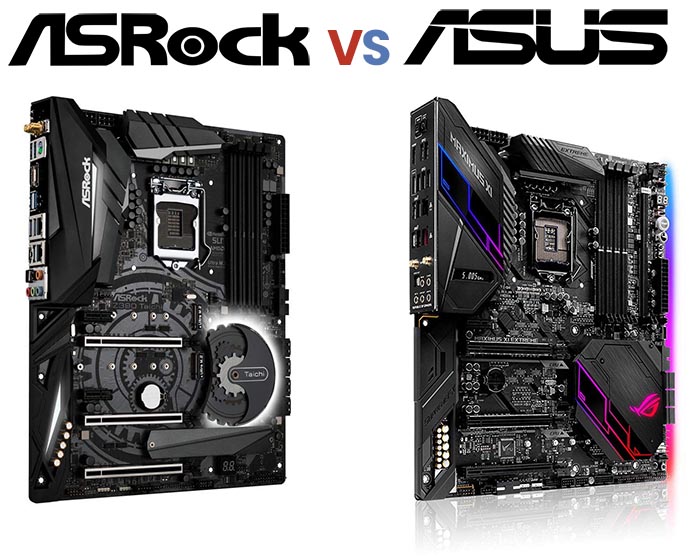I’ve built countless PC’s and recommended many motherboards for different needs.
ASRock or ASUS can both be great choices, but for different reasons.
Read on and we’ll figure out which brand is a better pick for you.
Reliability & Quality
First and foremost, you should be looking for a reliable motherboard.
Faulty motherboards cause some of the most difficult to troubleshoot problems – random reboots, shutdowns, and lockups.
A stable system is important whether used for productivity, entertainment, gaming, or as a server.
A good board will have use reliable chipsets and ports throughout, and utilize high quality capacitors and other components.
ASUS has a long history of quality. I’ve not known any of their recent boards to suffer from stability problems. I’ve seen plenty of their products in use for 10+ years with no issues.
ASRock is a newer brand, but they’ve both grown and improved over the last several years. Most would consider their quality to be on the same level as ASUS, and failure rates back that up.
I did run into stability problems with an ASRock AB350M PRO4, which a number of other owners also experienced. The problem seems to have been limited to that one model. I mention it because again, I’ve not seen any recent ASUS model be affected by stability issues.
Outside of one ASRock model I mentioned, I feel both brands make great, long-lasting products.
Value
At the low end, ASRock boards are priced around 10% less than comparable ASUS models.
At the high end, ASRock’s best motherboards are usually found below $300, while ASUS can reach $400 or more.
ASRock is the clear winner in value.
If you have a strict budget, you’ll be able to get more features for your money by going with ASRock.
Features
The differences in options and ports can be overwhelming between boards.
That makes it tougher to nail down the exact board you want. On the plus side, it keeps the price down – you can choose to spend on only the features you really need.
ASUS has a much wider selection of products.
If you’re looking for a certain number of USB ports, particular LAN chip, fan controls, or lighting, those features may be easier to find in an ASUS board.
BIOS
A great BIOS will have the following:
- Main page displaying temps, clock speeds, voltages, and fan speeds
- Well laid-out menus
- Full set of advanced options
- Simple and safe update procedure
ASRock and ASUS both make an excellent BIOS. In fact, I’d say they’re the two best out there.
Both offer an “EZ Mode” for general use. An “Advanced Mode” opens up all the device and overclocking settings you could need.
Is there anything that stands out between the two? Perhaps the ASUS BIOS looks a bit nicer. The only other thing that comes to mind is the Ultra Fast Boot Mode of ASRock.
Most brands including ASUS have a Fast Boot Mode, but ASRock’s Ultra Fast mode truly is quicker. Your operating system (Windows 8/10 or Linux) must be in installed in UEFI mode, and the default UEFI BIOS mode must be enabled rather than Legacy. Once enabled, ASRock has the fastest boot time of any motherboard I’ve seen.
Audio
The excellent Realtek AC1220 chipset is found on most mid to high-range boards from both brands.
Serious audiophiles will probably still opt for an external DAC + amplifier, but to most ears this chipset will impress.
Going with a lower-end board will get you an chipset like the Realtek ALC892 or ALC887. While these are adequate, if you listen to a lot of music, movies, or games, it’s probably worthwhile to step up to a midrange motherboard to get the AC1220 chipset.
LAN & Wi-Fi
With both brands, you’ll see Intel chipsets used for both wired LAN and 802.11 ac wireless on much of their lineup. That’s a good thing.
The exception is the LAN chips in the lower-end boards from both brands – these use Realtek. While fine for most users, if you are running a server or are gaming competitively it may be worthwhile to choose a model with an Intel chip.
Speaking of servers – ASRock’s Taichi Ultimate Intel & AMD boards offer 10 Gigabit ethernet, but no ASUS boards offer 10GbE as of this writing.
Ports
Six SATA ports is standard for most brands, ASUS included. ASRock is a good choice if you need even more, as many of their models have eight SATA ports.
For M.2 sockets, ASRock’s Z390 Taichi series of mobo offers a total of three rather than the typical two sockets you’ll find on all other boards.
Onboard headers are similar between comparable models, though ASRock usually offers a bit more chassis fan connectors.
USB ports vary greatly by model. If you’re looking for a certain number or type (3.0/3.1/Type C) I recommend checking the specs of each board you’ve narrowed down to.
Lighting
ASUS’s Aura lighting system is perhaps the most complete RGB system out there.
The Aura software is excellent. It offers nine lighting modes versus the ASRock Polychrome RGB Sync’s seven.
Product compatibility is best with Aura as well.
If RGB lighting is very important to you, ASUS is the way to go.
Overclocking
Achieving an overclock can be as simple as a couple of clicks in the BIOS. Or, it can be an entire hobby on its own.
The majority of overclockers are looking to squeeze more performance out of their CPU, GPU, and RAM without spending a ton of extra money.
Most mid-range motherboards can accomplish this; some better than others.
Extreme overclockers will likely compare components like chokes, MOSFETs, capacitors, and heatsinks between models. That’s more advanced than what I’ll get into here.
To keep things simple, I’d describe ASRock’s overclocking performance as “good.”
Most ASRock boards priced above $100 or so will overclock well enough to satisfy most people.
ASUS, meanwhile, is perhaps the best brand out there for overclocking – in particular their ROG series.
The settings available are more intuitive; ASUS even includes an overclocking guide in the BIOS menu.
From numerous reviews I’ve read, ASUS frequently performs at or near the top in terms of overclocking performance.
I’d look to ASUS if you see yourself maximizing your overclocks and want the best BIOS to do so.
Warranty & RMA Process
All recently produced mainboards from these two brands have 3-year warranties.
In my experience, ASRock is quick and straightforward to deal with during the RMA process.
ASUS RMA’s typically took a little longer for me. While I’ve had generally good experiences, I’ve heard of some mixed results with motherboard RMA’s. Boards are more easily damaged from mishandling by the user than a lot of other components. ASUS seems to be more particular about physical damage. If you RMA with ASUS, be sure to take good photos beforehand and use plenty of packing material.
Side by Side Comparisons
Dozens of motherboards are available with each chipset. Here I’ll focus on the Z390 chipset from Intel and the B450 and X470 from AMD. This should at least give you an idea of how offerings from ASRock and ASUS compare.
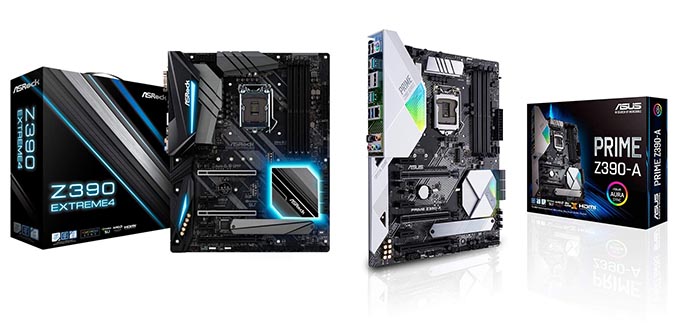
ASRock Z390 Extreme4 vs ASUS Prime Z390-A
Features
These boards are what I’d consider “upper-end” – they aren’t quite the top of the line, but they have everything that 90% of PC enthusiasts need.
These are socket LGA 1151 boards for 8th and 9th gen Intel Core CPU’s. Since they’re ATX you’ll need a mid or full tower case.
Let’s start off with what is the same:
- Realtek ALC1220 audio
- Intel I219-V gigabit LAN
- 3x PCIe slots
- Max 64GB RAM
- RGB lighting + 2 headers
- Multiple chassis fan & water pump connectors
There are a number of differences between the two.
The Extreme4 has more SATA ports (8) than the Prime (6).
The Prime has more USB 3.1 Gen2 ports (4) than the Extreme (2). Most of the Extreme’s ports are Gen1 which run at 5Gbps rather than 10Gbps.
The Extreme4 has an M.2 (Key E) for slot for adding an optional WiFi module instead of using PCIe or USB. This is in addition to the two standard M.2 slots both boards have.
The Extreme4 can run triple video cards at full x8 speed while three are limited to x8/x4/x4 on the Prime Z390-A.
Power consumption is a bit lower on the Prime at both idle and load.
Value
The Extreme4 has a bit more in the way of features, though these two boards are very similar.
Both boards are priced well at under $200 for being so feature-packed.
The Extreme4 can be found around $30-35 cheaper.
Overall Winner: ASRock Z390 Extreme4
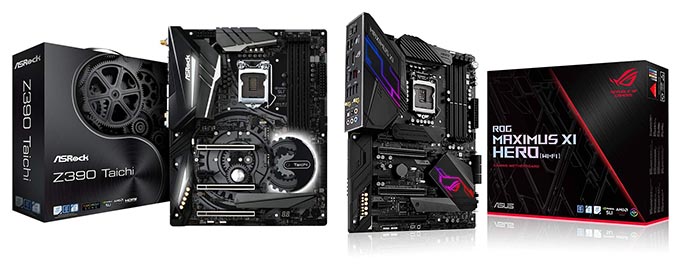
ASRock Z390 Taichi vs ASUS ROG Maximus XI Hero (Wi-Fi) Z390
Features
These are high-end, full featured boards that still won’t break the bank.
First, most people should skip the Taichi Ultimate.
Though the name sounds impressive, the only thing the Ultimate offers over the Taichi is 10G ethernet, which requires special hardware to take advantage of. Best to save the money if you won’t use it.
Back to the Taichi versus the Maximus XI Hero. Here’s what they have in common:
- Realtek ALC1220 audio
- 3x PCIe slots
- Bluetooth
- 802.11ac WiFi
- RGB lighting + 2 headers
- Multiple chassis fan + water pump connectors
The Taichi has several advantages over the Hero:
- Dual Intel LAN
- 3x M.2 sockets
- 2 additional SATA ports
- Triple x8 PCIe support
The Hero can support RAM up to DDR4 4400 versus DDR4 4200 on the Taichi.
Value
The Taichi has some nice additional features above the Hero as shown above. Getting dual LAN with ASUS would mean spending even more.
As it stands, the Taichi can be bought for anywhere from $80-110 less than the Hero. The savings are so significant that as good as the Hero is, it’s tough to recommend over the Taichi.
Overall Winner: ASRock Z390 Taichi
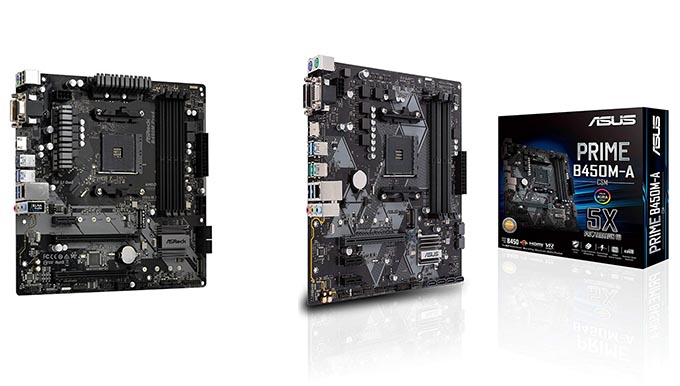
ASRock B450M PRO4 vs ASUS B450M-A/CSM
Features
Sometimes you need an affordable board but still want a great chipset for performance and reliability. B450M boards are a great choice in the AMD realm.
Since these are micro ATX motherboards (the “M” in the name is for Micro), they’ll fit micro ATX cases.
The B450M PRO4 and B450M-A/CSM both have Realtek audio and LAN, and four SATA ports.
The PRO4 adds a second M.2 socket, though it is limited to SATA3 speeds. There are a couple more USB ports at the rear as well.
The PRO4 uses (2) x16 + (1) x1 PCIe slot compared to (1) x16 + (2) x1 slots on the ASUS; since most users run microATX boards with one GPU, this will likely not make a difference.
While detailed benchmarks are not available on the ASUS board, I expect the two to perform very similarly.
Value
Pricing is nearly identical on these motherboards, with typical sale prices at or just below $80.
Overall Winner: Tie between the ASRock B450M PRO4 and ASUS B450M-A/CSM
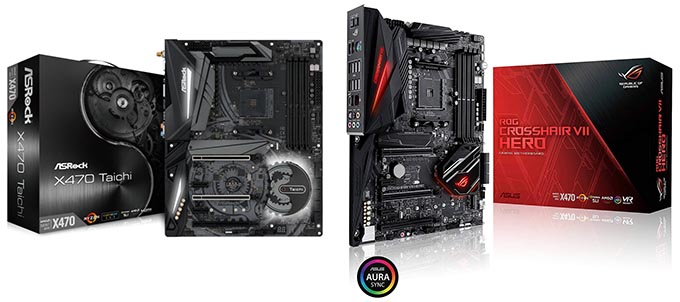
ASRock X470 Taichi vs ASUS ROG Crosshair VII Hero
Features:
Comparing the Taichi vs Taichi Ultimate, the only difference is a 10Gb ethernet port and higher price on the Ultimate.
Since most won’t make use of 10GbE, I’ll compare the standard Taichi here.
Here’s what features the Taichi and the Hero share:
- Realtek ALC1220 audio
- 3x PCIe slots
- 2x M.2 sockets
- Intel i211AT gigabit LAN
- RGB lighting + 2 headers
- Several chassis fan & water pump connectors
Connectivity is where the X470 Taichi sets itself apart.
The Taichi includes 802.11ac WiFi plus Bluetooth onboard. ASUS makes you pay about $20 extra for a WiFi + bluetooth version.
ASUS goes nuts on USB ports with their board. Compared to the Taichi’s eight, the Hero has a dozen rear USB ports.
Value:
ASRock once again shows their aggressive pricing strategy, with the Taichi selling for about $50 less.
Overall Winner: ASRock X470 Taichi
Conclusion
Deciding on a motherboard can be a tough call with so many options out there.
You really can’t go wrong with most of what ASRock and ASUS have to offer.
That said, ASRock has really made a push to offer more for your money. If you’re looking for the most features for your dollar, ASRock comes up on top for value.
There are still reasons to choose ASUS over ASRock. Between most comparable models, ASUS is better for overclocking. ASUS has also been producing motherboards longer. This has led to more a more reliable BIOS, software, and drivers, in my experience.

